Medical RPA
- 1.Challenges faced in the healthcare industry
- 2.Examples of tasks that can be automated
- 3.Case Studies
- 4.Service Menu
- 5.Flow until introduction
1.Challenges faced in the healthcare industry
By automating tasks such as data entry, search, and aggregation that were previously done by hand, we will address the chronic labor shortage in the healthcare industry.
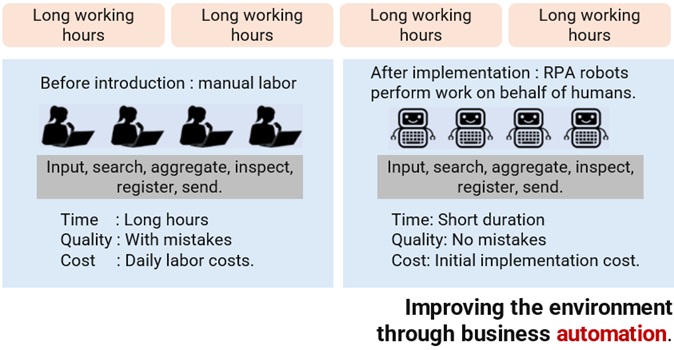
2.Examples of tasks that can be automated
Examples of automation in various operations of medical institutions.
| Target sector | Content |
|---|---|
| Examination Sharing Section |
|
| Nursing Department |
|
| Pharmacy Department |
|
| Medical office work |
|
|
General affairs (Attendance, accounting, etc.) |
|
3.Case Studies
Medical Institution Name: Asakawa Gakuen Dai Home Clinic
Release the director from 10 hours of holiday work.
BizRobo! contributes to home healthcare where one doctor sees 80 patients.
Target business
They are utilizing BizRobo! mini for a total of three tasks: issuing the "Home Care Plan" that doctors provide to patients every month, issuing the "Home Nursing Instruction" that doctors provide to home nursing stations every month, and issuing the "Monthly Medical and Nursing Care Cost Summary Invoice" that administrative staff prepare for patients every month.
In the issuance of home care plans, the process of entering the latest information for each patient into the SECOM OWEL template and printing it each time has been significantly streamlined using RPA. Specifically, a list of eligible patients for the following month is created from the database software managing various documents for each patient, and as long as the physician updates the notes for each patient on SECOM OWEL, the instructions for the listed patients are automatically generated.
Additionally, regarding invoices, the bulk printing of all items, which was difficult due to the software specifications, has been achieved through automated execution by RPA.

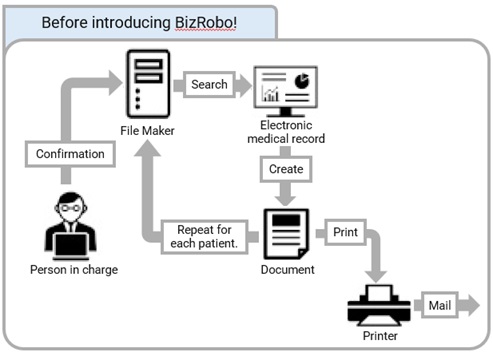
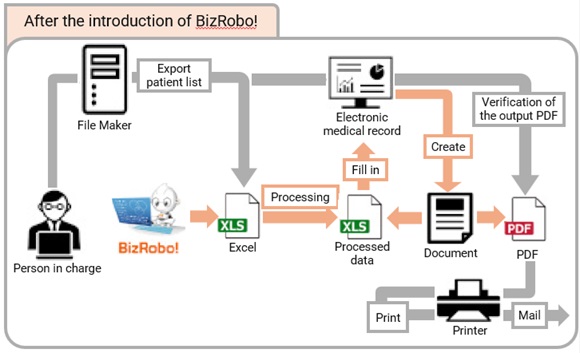
Introduction effect
Of the three types of operational robots, in relation to the issuance of home care plans and home nursing instructions, the work handled by the director has been reduced by up to 75%, creating just under 10 hours each month. The billing process, which clerks used to spend 5 hours on each month, has been almost completely automated.
While the average number of patients handled in private home care is generally around 50, this facility is accepting more than 1.5 times that number, which is analyzed as a "result of operational efficiency improvements, including RPA." "In particular, the creation of 80 home care plans each month, which used to take about 8 minutes per plan, now takes less than 2 minutes, allowing for more time and mental space at the end and beginning of the month," they smile.
With enhanced administrative processing capabilities, they have been able to secure private time even after dedicating half a day on holidays to assist with COVID-19 vaccinations, and they have become more proactive in accepting patients in the future.
Medical Institution Name: Fukuoka Prefectural Saiseikai Fukuoka General Hospital
Taking the urgent need for remote response as an opportunity, we are fully advancing DX. BizRobo! has reduced the visualized work time by up to 98%.
Target business
The institute, which has a policy of completing the development and operation of BizRobo! in-house without outsourcing, first had its system engineers learn to operate the tools through e-learning during the trial period. While utilizing online support, they have been repeatedly prototyping software robots. Currently, the institute is using two types of robots in practice: one that converts case data recorded at patient discharge into a CSV file every month and transcribes about 2,000 items related to approximately 20 cases each month to the case registration site "Japan Stroke Data Bank," and another that individually sends about 150 emails containing URLs that may be treated as spam by the receiving environment when sent in bulk. Furthermore, they are also advancing the robotization of the task of transcribing prices listed on invoices received from external vendors into the system by using the AI-OCR solution "BizRobo! OCR with AI inside," which is expected to go into full operation soon.

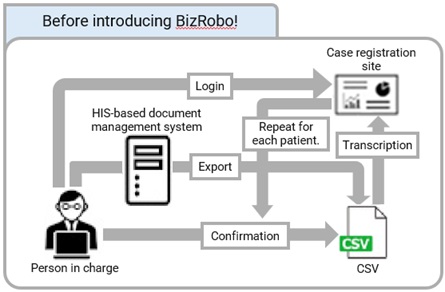
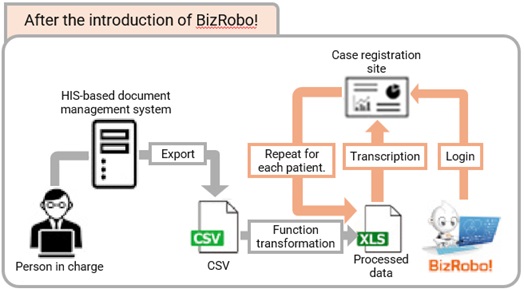
Introduction effect
By utilizing BizRobo!, the hospital has reduced the monthly case registration work, which used to take 2 hours per session, to just 30 minutes. Additionally, the manual process of sending individual emails, which previously took about half a day (4 hours), has been shortened to just 5 minutes.
As a result of starting with tasks that were already visualized through workload analysis and were easy to implement, and which promised greater time-saving effects, they successfully made a strong impression with immediate implementation results. Requests for further automation have been received from various departments in the administrative sector.
This is also because the benefits that go beyond the quantitative aspect of time reduction are supported in the office environment. The tasks of registering cases in the clinical department and emailing meeting URLs to the heads of external medical institutions are simple but absolutely error-free tasks. Not only did it free the staff from these tasks and reduce their workload, but it also had a significant positive effect on their mental health.
4.Service menu
Depending on the method of RPA implementation for medical institutions, you can choose support from JRC Engineering.
| Item | Content |
|---|---|
| Operational support |
|
|
Development Support (Robot Creation: Customer) |
|
| Robot creation agency |
|
*Supported areas: Tokyo, Kanagawa, Chiba, Saitama, Gunma, Tochigi, Ibaraki, Yamanashi, Shizuoka
*We will provide the standard robots created by our company in the past free of charge.
5.Flow until introduction
We will provide solid support for initial implementation, including environmental setup and creation of test robots during the trial period.
1) Create robots as a customer. (If environmental support assistance is not required.)

2) Customers will create robots. (If development support is needed)

3) We will create the robot on your behalf. (If you do not create the robot yourself, we will create it for you.)

*The environment and robots created during the trial period can still be used as they are after purchasing the license.
*The trial period is limited to a maximum of one month.
*The duration for development support and robot creation outsourcing is a guideline.
Inquiry
For inquiries regarding Medical RPA, please see below. Feel free to contact us.
